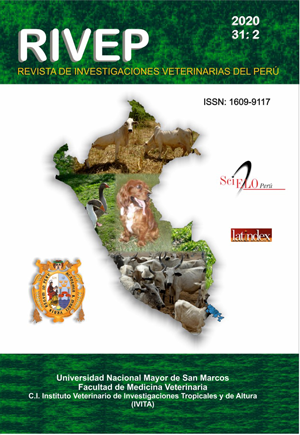Monthly prevalence and parasite load of gastrointestinal nematodes and Fasciola hepatica in dairy cattle from two districts of the Mantaro Valley, Junín, Peru
DOI:
https://doi.org/10.15381/rivep.v31i2.17819Keywords:
dairy cows, gastrointestinal nematode, Fasciola hepatica, epidemiological factors, McMaster Test, modified Dennis TestAbstract
The aim of this study was to determine the prevalence and monthly parasitic load of gastrointestinal nematodes and Fasciola hepatica in dairy cattle of the districts Nueve de Julio and Matahuasi el Mantaro Valley (Junín, Peru), as well as the epidemiological factors associated with these parasitosis. Monthly faecal samples were collected from 11 dairy farms in each district for one year. The samples were analysed with the modified Dennis technique for the detection and counting of F. hepatica eggs and the modified McMaster technique for nematode eggs. The mixed logistic regression test was used to evaluate the variables district, time of year, feeding system, age, temperature, rainfall and humidity as possible risk factors. The average monthly prevalence in Matahuasi and Nine of July for gastrointestinal nematodes was 24.5 and 30.3%, with monthly loads of 118.3 and 87.4 hpg, and for F. hepatica of 69.8 and 46.6%, with monthly loads of 7.5 and 3 hpg, respectively. The results indicate that gastrointestinal nematodiasis and hepatic fasciolosis are endemic in the area. The presence of nematodes is significantly associated with the increase in temperature and age, with calves being the most susceptible population, while fascioliasis is related to the increase in temperature and precipitation, and the time of the year, being significantly greater in the dry season. Likewise, a significant relationship was found between the presence of F. hepatica and the district of origin, the risk of infection being significantly higher in Matahuasi.
Downloads
Downloads
Published
Issue
Section
License
Copyright (c) 2020 Andrea Briones Montero, Ivonne Salazar Rodríguez, Gonzalo Suárez Veirano, Peter Geldhof, Daniel Zárate Rendón

This work is licensed under a Creative Commons Attribution-NonCommercial-ShareAlike 4.0 International License.
AUTHORS RETAIN THEIR RIGHTS:
a. Authors retain their trade mark rights and patent, and also on any process or procedure described in the article.
b. Authors retain their right to share, copy, distribute, perform and publicly communicate their article (eg, to place their article in an institutional repository or publish it in a book), with an acknowledgment of its initial publication in the Revista de Investigaciones Veterinarias del Perú (RIVEP).
c. Authors retain theirs right to make a subsequent publication of their work, to use the article or any part thereof (eg a compilation of his papers, lecture notes, thesis, or a book), always indicating the source of publication (the originator of the work, journal, volume, number and date).



